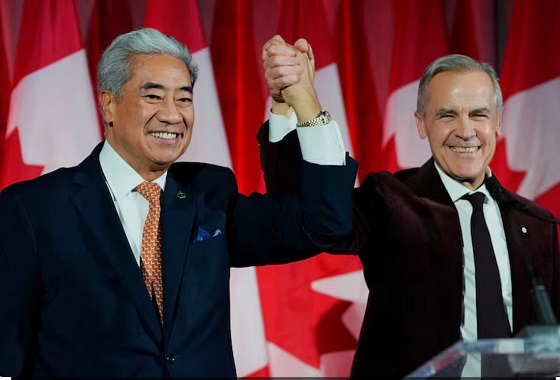Economy
After 140-Odd Years, Can’t We Figure Rail Out Yet?

From the Frontier Centre for Public Policy
A typical train these days has over 100 cars. Each rail car, depending on the load, is at least one, and often several truckloads. A train needs two crew to operate it. Are you going to come up with 100 to 200 truck drivers to replace that one, individual train, as well as the trucks, trailers, and space on the highways in a moment’s notice, and then do that for the entire economy?
In all the fuss about the Canadian rail disruption, one thing jumped out at me. Here’s how the National Post reported it:
“Despite the economic impacts, the Canadian Industrial Relations Board ruled earlier this month that the railway workers are not an essential service.”
Every member of this board should be sacked. Immediately. Because if rail is not essential, nothing is.
Did none of them pay attention in grade school? Canada was built on the railway. British Columbia joined confederation as a result, and all the gaps in between were filled in in large part because there was rail.
Yet every few years, Canadians and the Canadian economy is held hostage by some sort of disruption involving rail, usually a labour one, but occasionally a protest movement or even the weather, as if this is our first year living in the great white north.
The playbook is worn out already. After several days of pain and homage being paid to the rights of the workers to strike (yet no one talks about the rights of companies to lock out workers), the federal government eventually takes action and things get back to normal.
In this case, the feds let the entire rail network of CN and CPKC shut down on Thursday, Aug. 22, before ordering binding arbitration. But as I write this the morning of Friday, Aug. 23, the Teamsters have served strike notice on CN about an hour ago. I’m not going to try to keep up with all the developments. Maybe by the time this is published, it will all be resolved. But it seemed like that resolution was yesterday, and it fell apart today, so who knows?
And frankly, I don’t care, and I don’t think you should, either. Perhaps the union members have a point in their issues. Maybe the rail companies do, too. Fundamentally, it doesn’t matter. Sort it out. Put on you big boy/girl shorts/panties. Make it work.
At no point, ever, in the history of this nation, has rail service not been essential. From farmers needing to ship their grain at harvest to cities needing chlorine for water treatment to pavers needing asphalt from the Lloydminster refinery before the fall paving season ends, rail is utterly critical to our existence as a nation.
And anyone who says we can just backfill with trucks is a fool. A typical train these days has over 100 cars. Each rail car, depending on the load, is at least one, and often several truckloads. A train needs two crew to operate it. Are you going to come up with 100 to 200 truck drivers to replace that one, individual train, as well as the trucks, trailers, and space on the highways in a moment’s notice, and then do that for the entire economy?
Let’s look back at the rail blockades of 2020 in support of the Wet’suwet’en opposition to the Coastal GasLink pipeline. Because the blockades were related to First Nations politics, the federal Liberal government was loathe to step in. In a nod to George Orwell’s Animal Farm, it proved that in the 21st century, “some animals are more equal than others.” In this case, some First Nations were more equal than others, and could block rail lines at will, dramatically impacting parts of the economy. Never mind that the pipeline that was so ardently opposed is now the salvation for other First Nations bands to go ahead with their own Cedar LNG facility, dramatically improving their economic prospects.
Did the government perhaps learn something from the 2020 blockades – that rail disruption can’t allow these things to go on forever, especially because it would now impact the entire economy? Maybe. But if so, maybe the federal minister should have acted before an actual stoppage took place.
And that’s the key thing. Rail is nothing new to Canada. It’s almost as old as the nation itself. And yet there’s always something causing grief. Sometimes rail performance is blamed on snow in the mountains, or cold, as if this is the first time there’s ever been cold, or snow, or both, in Canada. Except they made it work for over 140-odd years, why are we now unable to make things work? Why, after the same 140-odd years of operation, we still have labour strife over rest periods and operations? Hasn’t that been enough time to figure it out, both from the company and labour sides?
How many more decades, nay, centuries do we need to figure out how to run a railroad?
Brian Zinchuk is editor and owner of Pipeline Online, and occasional contributor to the Frontier Centre for Public Policy. He can be reached at [email protected].
Business
Canada Hits the Brakes on Population

The population drops for the first time in years, exposing an economy built on temporary residents, tuition cash, and government debt rather than real productivity
Canadians have been told for years that population decline was unthinkable, that it was an economic death spiral, that only mass immigration could save us. That was the line. Now the numbers are in, and suddenly the people who said that are very quiet.
Statistics Canada reports that between July 1 and October 1, 2025, Canada’s population fell by 76,068 people, a decline of 0.2 percent, bringing the total population to 41,575,585. This is not a rounding error. It is not a model projection. It is an official quarterly population loss, outside the COVID period, confirmed by the federal government’s own data
The reason matters. This did not happen because Canadians suddenly stopped having children or because of a natural disaster. It happened because the number of non‑permanent residents dropped by 176,479 people in a single quarter, the largest quarterly decline since comparable records began in 1971. Permit expirations outpaced new permits by more than two to one. Outflows totaled 339,505, while inflows were just 163,026
That is the so‑called growth engine shutting down.
Permanent immigration continued at roughly the same pace as before. Canada admitted 102,867 permanent immigrants in the quarter, consistent with recent levels. Births minus deaths added another 17,600 people. None of that was enough to offset the collapse in temporary residency. Net international migration overall was negative, at minus 93,668
And here’s the part you’re not supposed to say out loud. For the Liberal‑NDP government, this is bad news. Their entire economic story has rested on population‑driven GDP growth, not productivity. Add more people, claim the economy is growing, borrow more money, and run the national credit card a little harder. When population growth reverses, that illusion collapses. GDP per capita does not magically improve. Housing shortages do not disappear. The math just stops working.
The regional numbers make that clear. Ontario’s population fell by 0.4 percent in the quarter. British Columbia fell by 0.3 percent. Every province and territory lost population except Alberta and Nunavut, and even Alberta’s growth was just 0.2 percent, its weakest since the border‑closure period of 2021
Now watch who starts complaining first. Universities are already bracing for it. Study permit holders alone fell by 73,682 people in three months, with Ontario losing 47,511 and British Columbia losing 14,291. These are the provinces with the largest university systems and the highest dependence on international tuition revenue
You’re going to hear administrators and activists say this is a crisis. What they mean is that fewer students are paying international tuition to subsidize bloated campuses and programs that produce no measurable economic value. When the pool of non‑permanent residents shrinks, departments that exist purely because enrollment was artificially inflated start to disappear. That’s not mysterious. That’s arithmetic.
For years, Canadians were told that any slowdown in population growth was dangerous. The truth is more uncomfortable. What’s dangerous is building a national economic model on temporary residents, borrowed money, and headline GDP numbers while productivity stagnates. The latest StatsCan release doesn’t just show a population decline. It shows how fragile the story really was, and how quickly it unravels when the numbers stop being padded.
Subscribe to The Opposition with Dan Knight
Business
White House declares inflation era OVER after shock report

The White House on Thursday declared a decisive turn in the inflation fight, pointing to new data showing core inflation has fallen to its lowest level in nearly five years — a milestone the administration says validates President Donald Trump’s economic reset after inheriting what it calls a historic cost-of-living crisis from the Biden era. In a statement accompanying the report, White House Press Secretary Karoline Leavitt said inflation “came in far lower than market expectations,” drawing a sharp contrast with the 9 percent peak under President Joe Biden and arguing the numbers reflect sustained relief for American households. “Core inflation is at a new multi-year low, as prices for groceries, medicine, gas, airfare, car rentals, and hotels keep falling,” Leavitt said, adding that lower prices and rising paychecks are expected to continue into the new year.
According to the White House, core inflation — widely viewed by economists as the most reliable gauge because it strips out volatile food and energy costs — is now down roughly 70 percent from its Biden-era high. Officials noted that if inflation continues at the pace of the last two months, it would be running at an annualized rate of about 1.2 percent, well below the Federal Reserve’s 2 percent target. The report also highlighted broad-based price moderation across consumer staples and services, with declines in groceries, dairy, fruits and vegetables, prescription drugs, clothing, airfares, natural gas, car and truck rentals, and hotel prices. Average gas prices have fallen to multi-year lows, while rent inflation has dropped to its lowest level since October 2021, a shift the administration attributes in part to tougher enforcement against illegal immigration and reduced pressure on housing demand.
Wages, the White House says, are rising alongside easing prices. Private-sector workers are on track to see real wages increase by about $1,300 in President Trump’s first full year back in office, clawing back purchasing power lost during the inflation surge of the previous administration. Gains are strongest among blue-collar workers, with annualized real earnings up roughly $1,800 for construction workers and $1,600 for manufacturing employees. Administration officials also took aim at critics who warned Trump’s tariff policies would reignite inflation, arguing the data shows no demonstrable inflationary impact despite repeated predictions from Wall Street and academic economists.
NEC Director Kevin Hassett on the latest inflation report: "It was just an absolute blockbuster report… We looked at 61 forecasts, and this number came in better than every single one of them." 🔥 pic.twitter.com/rBJpkmjuNa
— Rapid Response 47 (@RapidResponse47) December 18, 2025
Even commentators across the media spectrum acknowledged the strength of the report. CNBC’s Steve Liesman called it “a very good number,” while CNN’s Matt Egan said it was “another step in the right direction.” Harvard economist Ken Rogoff described the reading as “a better number than anyone was expecting,” adding, “There’s no other way to spin it.” Bloomberg’s Chris Anstey noted the figure came in two-tenths below the lowest estimate in a survey of 62 economists, calling it “remarkable,” while The Washington Post’s Andrew Ackerman wrote that inflation “cooled unexpectedly,” easing pressure on household budgets.
For the White House, the message was blunt: the inflation era is over. Officials framed Thursday’s report as proof that Trump has followed through on his promise to defeat the cost-of-living crisis he inherited, laying what they called the groundwork for a strong year ahead. As the president told the nation this week, the administration insists the progress is real — and that, in his words, the best is yet to come.
-

 Business18 hours ago
Business18 hours agoCanada Hits the Brakes on Population
-

 Crime6 hours ago
Crime6 hours agoBrown University shooter dead of apparent self-inflicted gunshot wound
-

 Business2 days ago
Business2 days agoOttawa Pretends To Pivot But Keeps Spending Like Trudeau
-

 Energy2 days ago
Energy2 days agoLiberals Twisted Themselves Into Pretzels Over Their Own Pipeline MOU
-

 Censorship Industrial Complex2 days ago
Censorship Industrial Complex2 days agoHow Wikipedia Got Captured: Leftist Editors & Foreign Influence On Internet’s Biggest Source of Info
-

 International2 days ago
International2 days agoBondi Beach Shows Why Self-Defense Is a Vital Right
-

 Crime2 days ago
Crime2 days agoThe Uncomfortable Demographics of Islamist Bloodshed—and Why “Islamophobia” Deflection Increases the Threat
-

 Agriculture17 hours ago
Agriculture17 hours agoWhy is Canada paying for dairy ‘losses’ during a boom?










